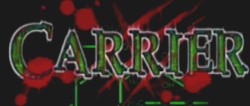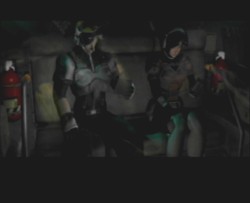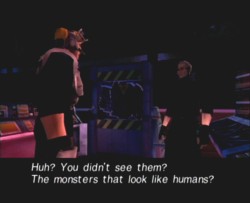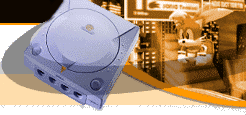Call it "Swabbies vs. Sickies." By any name this game is worth a look - Review By Jetzep
 Back in the '70s, The Village People sang a song called "In The Navy."
They never mentioned that if you joined you'd have to suffer through
helicopter crashes, attacks by virus-infected shipmates, tirades by
demented doctors, and confusing orders from "the brass." All this and
more is in store for you in Carrier, the first Dreamcast title from
Jaleco.
Back in the '70s, The Village People sang a song called "In The Navy."
They never mentioned that if you joined you'd have to suffer through
helicopter crashes, attacks by virus-infected shipmates, tirades by
demented doctors, and confusing orders from "the brass." All this and
more is in store for you in Carrier, the first Dreamcast title from
Jaleco.
Here's the opening plot in a nutshell. Sometime in a dark and twisted
future, North will be fighting South (which nations are involved isn't
germane to the game, though the North side will probably include lots of
countries comprised of fair haired, light skinned Caucasians, since most
of the game's cast looks like this). The North attacks the South with
its super aircraft carrier, the Heimdal, and destroys the Southern
Cross terrorist base. But on its way back to port, the Heimdal falls
mysteriously silent.
You play through the game as one of two field agents: Sergeant Jack
Ingles, a brave super agent, and Jessifer (Jessifer??) Manning, a
volunteer from the agency's Information Department. On approaching the
Heimdal, automatic defense systems track the duo's helicopter, and
shoot it down. Heroic action by the pilot brings you down on the flight
deck, but Jessifer (again Jessifer??) is thrown clear before the
chopper crash lands. You start out as Jack (probably because you hate
your name so much as a female character), but switch to Jessifer later
in the story.
Once on board the Heimdal, you discover pretty quickly that things
aren't quite how you thought. Most of the crew has been transformed into
horrible creatures by a malevolent virus. Those infected first become
like walking zombies. Later, they mutate into creatures that can split
their heads apart into nasty stinging, biting maws. Any crew that remain
unaffected by the virus are: a) terrified, b) somewhat incapacitated by
the fighting that's been going on, c) rendered insane by the terrifying
events that have been taking place, or d) all of the above.
Well, true believer, that's the beginning. Where you go from there is up
to you!
The Good

The plotline is established with standard FMV. |
For starters, Carrier combines some very cool graphic and gameplay
elements into one slick package.
*Atmosphere:* Using an aircraft carrier for the story's setting is pure
genius. Most who have watched "JAG" or "Under Siege" know what the
inside of a ship looks like, but few have actually served aboard one.
This gives the game's designers lots of artistic license to create
environments that fit into the story line even as they maintain their
authenticity. The game's back story also goes into great detail on how
the carrier is the newest in the fleet, which makes the visuals of blood
stained walls, trashed corridors and flickering lights all the more
unnerving.
Gadgetry: The designers of Carrier went out of their way to make up
for the shortcomings of your character, like seeing in darkness,
spotting invisible bad guys, and viewing past pesky walls and bulkheads.
How did they do this? The BEM-T3 scope! It's one of the coolest gadgets
you could ever pick up and it should be standard issue for anyone else's
Resident Evil style game. (By the way, anyone who has been around cheap
sci-fi movies knows that BEM stands for Bug-Eyed Monster. It's really
cute to see a game trot a pun like this and leave it so far out in the
open).
As I said, the BEM-T3 scope is pretty nifty. It functions as a night
vision scope, has diagnostic properties that help determine which of the
carrier's crew have been corrupted, and even makes some of the carrier's
walls semi-transparent. Oh, much less publicized, it has a Swiss army
knife-like attachment, tiny magnifying glass, a Buzz Lightyear compass
and is powered by a small hamster in a cage (which can also be used as
emergency rations). Before you guys start looking in your inventory for
the hamster, I'm just joking!
The BEM-T3 scope adds depth, suspense, and playability to the game.
Resident Evil doesn't even come close to it in the "cool gadget
department."

Carrier's atmosphere is great. |
Shoot, And Shoot Again: Jaleco wants to make this game appeal to the
mass market gamer so they streamlined weapons use. You can select any
weapon at any time. Aiming and firing are made simple because the
auto-aiming cursor can be moved up or down with ease (as opposed to just
High, Medium, and Low).
Also, there are enough buttons to do anything you need to do. You can
check maps, switch weapons, aim and shoot, and use the scope, all with a
coordinated bunch of button pushes. Within a few minutes of picking up
the game, you can handle things pretty well. In many cases, especially
at the beginning of the game, I used the Directional Button instead of
the Analog Stick, simply because I wanted to be sure of where I was going.
The Stick is for when you want to beat feet away from an enemy or toward
a distant goal. The Directional button is good for when you're in close quarters or when you're
searching a room.
No Brainers: The puzzles and challenges in Carrier don't take a PhD to
solve (which is refreshing). An average game player will probably take
20 - 30 hours to crack it; rocket scientists will require considerably
less. Helpfully, anything that needs to be picked up is carefully marked with a
symbol or a flashing light.
The Bad
Weapons are an issue in Carrier. Your standard issue sidearm isn't a
sidearm at all. It's a welder. This is actually kind of fun because it
incapacitates the monsters with an electroshock that's fun to watch. The
other weapon that comes standard is a 9mm automatic, but you can run out
of bullets quickly if you don't ration them carefully. Other than that,
you can find a submachine gun and a T-7 bomb loitering around in various
places, but that's it. Waaaah!!

Most cutscenes utilize the in-game engine, with varying degrees of success. |
Other positive items, like ID cards, energy drinks, reloads, and the
BEM-T3 scope really don't make up for the fact that there's not enough
variety in the things you use to blow stuff up.
Carrier's other negatives are small stuff; quite piddly, really.
First, the game takes a bit too long to get into the really scary stuff.
As in movies, there should be an immediate, "Wow, that scared me so bad
I thought my eyeballs were going to blow up and my head implode." Well,
Carrier is definitely creepy at the beginning, but taking so long to
build to the first fear crescendo will definitely be a downer for some
fans of the genre.
While essential to moving the plot forward, the cut scenes are a bit
too drawn out. The game's designers are asking too much of their in-game
models to emote about how ghastly things are, since they have only a limited range
of facial expressions. It's mostly the character's voices that carry
these scenes, and that's just not enough. Luckily, there are terminals
placed liberally around the ship that allow you to save your progress
and, in most cases, avoid having to experience the cut scenes more than
once.
Also, most of the animation appears to be anything but motion captured.
While it makes the game easier to program, it also imbues each character
with a robotic appearance that doesn't jibe with the scariness of the
plot.
Lastly, there are issues with localization. How do you know that a
game was made first for a non-US market? The voice says, "Hey, who's
there?" but the lips are saying something much, much longer, that's how.
This is bothersome, but at other times the lips of the characters are
just opening and closing to simulate speech patterns. Lame.
The Final Word
While Carrier may not have the name recognition of a Resident Evil, it does
have everything else that a fan of survival horror videogames could want, such as
a scary plot, creepy monsters, and decent controls. Try Carrier out for
yourself, and you'll have a Dreamcast-style barometer to use when
measuring Resident Evil: Code Veronica next month.

